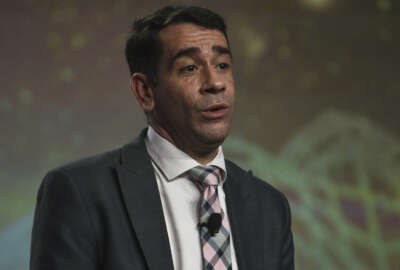DoD Cloud Exchange 2024: Army’s Leo Garciga on clearing obstacles to digital transformation
The Army CIO expects the service's new software development policy will bring better capabilities to soldiers faster.
Leonel Garciga has been on a sprint with a bulldozer.
Since becoming chief information officer of the Army last June, Garciga has been clearing policy obstacles, built up over the course of decades, to help spur digital transformation from the private to the general to the service’s secretary.
For most, the job of CIO is a marathon. But Garciga needed to start at a sprinter’s pace to — in the words of Army Secretary Christine Wormuth — “start breaking through the bureaucracy of the department.”
Even so, he acknowledges that the marathon part of his job will begin once the policy obstacles are cleared. But for now, he continues to open the throttle on the bulldozer.
“If it’s a policy challenge, if it’s a standard operating procedure challenge, I’m the guy with the pen. Help me fix that. If you’ve got lessons learned inside industry or in the commercial space, bring those standard operating procedures, bring those policies over, bring those guardrails over. Let’s put it on paper, and let’s get it signed out. Don’t let that prevent us from delivering,” Garciga said during Federal News Network’s DoD Cloud Exchange 2024.
“That’s the big thing that I keep pushing. Instead of saying, ‘Hey, policy doesn’t let me …,’ tell me this is what the policy should say, and let’s get that signed out. Let’s work through the friction and get that done. I continue to tell folks like that’s where we need the most help. We need to make sure that we get that alignment done because right now you’ve got someone who likes moving really fast, and I’m willing to underwrite a significant amount of risk when it makes sense.”
Focusing on 5 software reforms for Army DevSecOps
In March, Garciga pulled out his bulldozer to topple the Army’s approach to software development. Wormuth issued a new agile software policy detailing five changes to reform what she called the institutional processes of the Army.
The software reforms include everything from changing the way the Army writes requirements to emphasizing flexible acquisition approaches and training the workforce in these methods.
Garciga said the policy changes will help the service streamline its ability to build contracts based on agile and DevSecOps methodologies.
“A really big push includes centralizing some of that work at an acquisition digital center of excellence, which will be focused around these core agile contracts that we want to get out the door to support software development efforts,” he said. “The next big piece is really changing our approach to requirements by taking the holistic view we’ve had before to write these large dissertation type requirements and scaling them down to capability needs statements. So what it really does is take that requirements process and bring it down to core functionality versus those [individual systems] and allowing teams to have a little bit more left and right limits as they move forward.”
These changes aren’t just for IT or development teams. Garciga said the acquisition and nonacquisition workforces, as well as the test and evaluation experts, must all move in the same direction to meet the Army’s digital transformation goals. Otherwise, he said, creating a modernized foundation to build off of will be more difficult.
The Army can’t just write a policy and expect change to happen, which is why Garciga said the new digital center of excellence at Aberdeen Proving Ground in Maryland will take the lead in procuring software.
“The center will include subject matter experts who understand software development, who can help customers really flesh out how they want to get from that contract, put it in place in the most agile way that really does include all those requirements for agile development, sprint cycles and all those things that you need expertise in,” he said.
“The other piece, which is a Step 2 that’s happening simultaneously, is a team the CIO’s office is standing up. It’s a very small cell, which is really focused on helping either big programs or really critical programs in the Army run through the wickets of a better software contract. Whether it’s legacy stuff that we have that may need some shaping to get the right agile contract in place or to get the right task orders in place, we would bring our expertise with some software development experts and some engineers to help the command or the program really reshape their contracting efforts in coordination with the center of excellence for digital contracting.”
Turning to industry partners for Army cloud assist
The software expert cell already is working with a handful of Army commands on specific and critical programs. Garciga said the next step is to create a governance structure to help manage expectations and data. He said that will come together this spring.
Garciga expects that the changes will help the service work better with existing and potential vendor partners.
“With the traditional contracting approach, we alienated some of our more leading edge partners because we were telling them to go backwards to deliver,” he said. “I think that this is going to give some flexibility to these companies to bring in some expertise and so they can more healthily compete in the environment. For some of the folks that have been supporting us a long time, are good partners who haven’t had the opportunity to take that next step, this is really going to give them a landing pad to accelerate some of those efforts.”
Along with the new software policy, Garciga has led the effort to update guidance around reciprocity of security authorizations, use of a software container policy and a new software as a service policy.
All of these efforts, of course, are underpinned by the use of cloud services. To that end, Garciga said his office is close to releasing the revamped cArmy platform, with cArmy 2.0 launching possibly in the April.
The service added agility based on all the lessons learned and made the cloud platform bit more user-friendly for Army partners, Garciga said.
“A lot of work is happening in that space. We’re working the AWS side to create a new landing zone. We’ll start to transition some of the existing customers into a new landing zone, which I’m excited about because it’s going to ease a lot of their pain and some of their challenges with just getting day-to-day operations done,” he said. “Then after that, we’ll move on to Microsoft Azure, and we are still looking at where we have opportunity with some of our other cloud service providers.”
Applying lessons from early Army cloud moves
The decision to update C-Army meant the service took a “tactical pause” over the last few months in moving workloads and applications to the cloud.
Garciga said the pause let the Army reevaluate its delivery model around cloud services.
“Like most traditional folks and enterprises who moved to the cloud, we raced in some areas, and we made some mistakes. We did some things that made sense at the time but don’t make as much sense now. And as new cloud services have become available in the regions across all our cloud service providers, it’s really caused us to rethink some of some of the technical work that’s been done,” he said.
“We made some decisions that made sense to do, like physically lifting and shifting a capability and just run the infrastructure as a service. It made sense at the time for the services that were available and for what we were trying to do to overcome some challenges that we had as an Army and in some of our server rooms. But we did that probably in the least optimized way. As we’re now two, three, four years down the road, we’re like, ‘Wow, that’s really suboptimized. Our costs are really high here.’ ”
That’s particularly true for some of the services and systems the Army move to the cloud early on, Garciga said. The end result? The Army created new legacy technology debt in the cloud, he added.
The new C-Army platform should streamline the service’s ability to deliver core enterprise cloud services, reduce the number of trouble tickets the help desk receives and provide standardized templates for vendors and customers alike.
“You can be a little bit more predictable on what kind of capabilities you want to deliver and how you want them delivered. We are really focusing on some foundational things that will allow the acquisition community and our partners to understand what the environment looks like in a more streamlined way,” Garciga said.
“We will streamline onboarding services and really automate as much of the onboarding for customers as we can. We really want to deliver a lot of the information upfront. What does the environment look like? What do our images look like? What baseline managed services are we delivering as an Army to your tenant? Getting that out is hugely important. So our focus is going to be making sure that we make that available to all the folks that are coming into the environment. This will make it a little bit easier for folks to come in.”
Discover more articles and videos now on Federal News Network’s DoD Cloud Exchange event page.
Copyright © 2025 Federal News Network. All rights reserved. This website is not intended for users located within the European Economic Area.
Jason Miller is executive editor of Federal News Network and directs news coverage on the people, policy and programs of the federal government.
Follow @jmillerWFED






